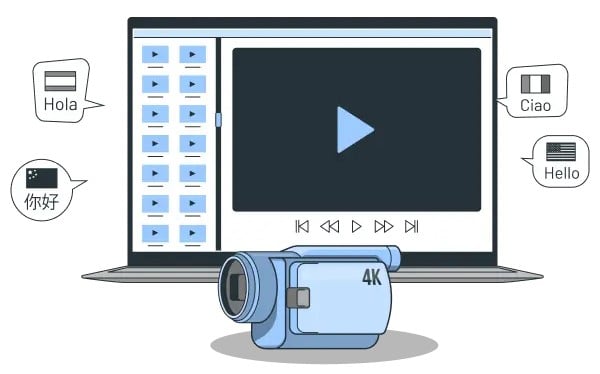[00:00:01] Kevin: Welcome to What Matters Most, Sands Capital’s podcast series in which we explore some of the trends in businesses that are propelling the pace of global innovation and changing the way we live and work today and into the future.
[00:00:12] Today, we’re talking about a company with a long and storied history, a global powerhouse with a fan base of more than 400 million worldwide.
This is the first investment of its kind for Sands Capital and one you might be surprised by. Today, we’re talking about Formula One [F1] racing with technology analyst Ben Betcher.
This company has a 70-year history—one that, before Liberty Media took over, Ben has described as being run like a combination of the Mafia and a 1980s media company.
But with the ousting of the old leadership and the advent of new technology, Formula One has transformed. In 2017, following the purchase of the commercial rights to the sport, Liberty Media announced its vision for the future of Formula One Group.
Liberty identified several key areas, including increasing the promotion of F1 as a sport and a brand, developing more of a digital presence, and increasing commercial partners and monetization while maintaining the sport’s relevance to road cars and OEMs [original equipment manufacturers]. Now, how does all this translate into the potential value for clients?
Well, let’s go ahead and dive into it. Ben, thanks for joining us here today. Let’s set the stage for everyone to start with. Again, I mentioned at the outset that this is an unusual kind of investment for us, and I think it’s a business that isn’t all that well understood.
So maybe we’ll start with a 30,000-foot view of the industry in general. And then what, you know, F1 looks like more specifically.
[00:01:38] Ben: Well, great. First, thank you for hosting me, Kevin. Always love chatting about Formula One.
For those who are less familiar, Formula One is the highest class of single seat auto racing globally. Liberty Media acquired Formula One Group in 2017, and these are world-class media investors just applying common sense to a significantly undermonetized asset.
I think, just to address your question, for most businesses, there is some product, some good or service that we need to evaluate. We need to understand it in terms of buyers, suppliers, pricing power, switching costs. And those same concepts apply to Formula One, but the product itself is entertainment.
So throughout history, a consistent trend that I’ve noticed has been that communications networks have been underestimated. And that can be radio, it can be television, internet. Even in the AOL era, it’s “Why do we need broadband, right? It’s working just fine.” Then YouTube hits, and, OK, now there’s video. Each time, it has been “use cases” [specific examples of how to use a technology] that have defined the way that has moved each technology from limited use to ubiquity.
So it was actually sports. It was a boxing match—Jack Dempsey about a century ago—that really showed the masses that radio had a broad use case. People packed into theaters all around the U.S. to hear this really low-quality retransmission of a radio signal, and it opened the minds of Americans and sports promoters on the business side to how one match, one finite piece of inventory, can be monetized millions of times over across the country. And it sounds like the internet or software, right?
Kevin: Yes.
[00:03:13] Ben: So the internet’s really just the latest chapter of telecommunications and sports rights. If we fast forward to the 1970s, it was again a boxing match. This time, it was Muhammad Ali and Joe Frazier at the “Thrilla in Manila.” It was the first time that a nonbroadcast pay TV station, this time HBO, had broadcast a sporting event live.
Fast forward again to today, the idea that almost everyone now has this mobile phone in their pocket that can be used to stream HD [high definition] color video of cars going up to 230 miles an hour and leagues being paid billions of dollars just for the right to show that video, we’ve come a long way. And a key point here that I’d make—and this helps explain why Formula One can be a little bit earlier in that monetization curve—is that leagues have not always been big business, nor have leagues always understood the value of mass distribution.
Take Major League Baseball [MLB]. They were actually concerned at one point that television would displace in-person attendance. So the commissioner reportedly tried to make a rule that the broadcast could not be a better view than a seat in the stadium. So in the late ’70s and ’80s, when TV developed, there were only a few broadcast networks, and it’s really when the business of sports became more unleashed.
So take the Cable Cowboys as they’re known. They were led by John Malone himself. He’s the chairman of Liberty Media. They really invented the cable industry.
He knows this better than anyone. So they built out the cable networks. ESPN was born, the regional sports networks proliferated. And just for another bit of perspective on how much this changed the value of the leagues, NBA [National Basketball Association] rights in 1970 were $2 million annually. Now they’re over $2 billion, so, million to billion. The one thing that’s been a constant over time is that sports have scarcity value and built-in audiences, which gives broadcasters certainty.
[00:04:57] Kevin: That’s interesting. I’m a fan of the sport, but I really have very little understanding of how the business works. Can you explain Liberty Media as the owner of F1? How does that work?
Ben: Yes, the reality is that the corporate structure is a lot more complex-seeming than the business itself. Liberty Media owns several different assets, including the Atlanta Braves. They have a large stake in Sirius XM and other stakes as well. So what we’re investing in, what investors are investing in when they’re investing in Formula One, is a tracking stock because the reality was that not everybody who wanted to invest in Formula One wanted to own a satellite radio business.
[00:05:37] Kevin: OK, interesting. Well, let’s back up before we talk specifically about the changes that Liberty Media brought. Walk us through how Formula One makes money. I know there are kind of three different business lines or revenue-generating units, maybe four if you include the “other” category. But walk us through each of those, and then we can dive into how Liberty Media has maybe changed or enhanced the revenue line on each.
Ben: Formula One is the highest class of single seat auto racing globally. There are 10 teams. There are two drivers per team. So there are 20 cars that are all racing in 22 Grand Prixs per year. The teams are called constructors. You can think of this just like any Premier League team or NFL [National Football League] team. Red Bull is one, Mercedes is one, Ferrari is another. They’re literally constructing the car from the ground up every year.
And so they range from OEMs like Mercedes, but also you have [teams like] Red Bull who are brands. You have private owners, like Haas, and each of them is trying to win the race. They have different sets of motivations depending on who they are, but the baseline is the same. They need to develop the car. These are very expensive, most technologically sophisticated cars being built in the entire world.
They can cost hundreds of millions of dollars to develop. And the entire power unit, of which the heart of that is the engine, that can cost up to roughly $10 million. So Kevin, you can’t take this into an Auto Zone if you hear a rattle in the engine. And some perspective on that number is that a NASCAR engine, rough numbers is it can cost closer to $150,000. So it’s truly state-of-the-art racing, highly technical. Some teams have a thousand employees. These are race engineers, tire engineers, data engineers, simulators, all the logistics and operational support for the team. Another perspective on how big this is: Take the highest payroll team in Major League Baseball. It’s over $300 million. In the NFL, I think it’s closer to $250 million.
The highest-spending team in F1 is closer to $500 million, roughly. The Formula One league itself makes money from the race hosting fees, which promoters in each track are paying to them.
So when they travel to Silverstone [a circuit in the U.K.], there’s a racing club that’s paying Formula One a fee. When they’re going to Miami, there’s a promoter there who pays them a fee. And then there’s sponsorship. So Heineken is a big sponsor. Rolex. Amazon Web Services [AWS]. Sometimes, they’re at the front of the race Grand Prix name. Other times, they’re on the track itself, or they’re official sponsors. And so they’re paying Formula One for the right to brand themselves along with the sport. And then there are the TV rights. So the broadcast rights are really filmed one time, and then they’re sold globally.
[00:08:30] Kevin: Yes, actually that … we’ll get into the other two categories in a second, but that raises an interesting battle ongoing right now between linear and over-the-top or streaming. Is this the end of linear, or will there be a place for F1 on broadcast TV into the future?
Ben: Yes, and it gets back also to the global nature of the sport. We tend to overindex to our experience, but pay TV penetration, broadband penetration, mobile phone penetration are in different stages across the world. And also the value proposition of the bundle—the linear bundle—is different by country. But, you know, I think this gets back to the heart of the question that we were discussing when we first were evaluating to invest in F1, which is why are sports leagues even attractive to own? And I think it’s a natural question. Frankly, I don’t think there’s a catch-all answer. For instance, I’m not sure we would want to own the MLB if it were a publicly traded asset.
I would just say, it’s not a truism that sports rights go up forever. The linear bundle, as we know, is now becoming the sports bundle.
But the short answer is that if you combine an undermonetized starting point for F1, leagues have the most valuable IP [intellectual property] in entertainment. So the partners of them can bank on a certain amount of built-in audience. And you take the great management team, and it’s a good combination, right? And leagues extract the most value in the sports value chain.
So there’s one point of view that, as the linear bundle erodes, this is going to be bad for sports rights because there are less people watching it. And so now ESPN and others need to move from a model of extracting a certain amount of affiliate fees for a larger pay TV sub base, which is to some extent being subsidized by people that don’t watch sports, to a more targeted one, meaning that anybody who does care about sports is now going to need to pay more for it.
But if you think about what drives the bundle, it’s news, it’s sports.
Historically, it’s been general entertainment. So cable news is actually a relatively new phenomenon. CNN was founded in 1980 and didn’t take off until the ’90s, but what is the news?
It’s a commodity. It’s just been repackaged as entertainment. So it really leaves sports as their only truly unique, impossible-to-replicate content, and that’s why it’s so valuable.
[00:10:46] Kevin: Yes, that’s interesting. I think we could spend a lot of time on that one.
Ben: Oh, yes. And so these are the three big revenue streams. Broadcast rates are about 35 percent of revenues. The hosting fees are about 30 percent. The sponsorship line item is a high-teens percentage of revenue. And then there’s an “other” line item that’s about a high-teens percentage of revenue as well, which comprises a bunch of different buckets, including their VIP tickets, which they do sell on their own.
So that’s how the league makes money, and then the teams will get a percentage of that.
[00:11:15] Kevin – So, how’s prize money split?
Ben: Yeah, there’s a sliding scale in terms of who gets what, but there’s a variable prize pool that goes to the teams, and they earn more money if they finish higher in the race, they earn less if they earn less. And so your ability to succeed in this is to some extent dependent on how successful you are in building a car. It’s not a perfect correlation one to one. Ferrari is one of the highest spenders. They’re not having a very good year. Red Bull is not the largest spender. They are having the best year. But there is a correlation there.
And one other thing I’d say is that I think it’s an important point. It’s something that I cover a lot of consumer internet businesses.
I think of that with F1, that comparison. Or that Bill Gates definition of a platform. Even though F1 is not a platform in the traditional sense, there are some parallels. There’s a large demand funnel on one end to consumers who really want to be entertained. There’s a league, and then there’s the brand who wants to plug into that and sponsors that want to plug into that, and so teams are helping to create this product, and then the broadcast partners and sponsors plug into that demand. And it’s clear that the entire ecosystem benefits from a stronger league. So what’s good for F1 is often good for the teams, the drivers, the promoters, the track owners, the local governments who get more tourism, the sponsors, and the broadcast partners. So the league becomes more effective in monetizing the sport. Everybody benefits. And what’s happened in the last couple of years is that the entire ecosystem has become healthier than it’s ever been.
Don’t get me wrong, there are haves and have-nots in F1, but it used to be the case that teams were running out of money all the time. They were finishing towards the bottom of the barrel in terms of the prize pool because they were finishing toward the end in the races. There are questions of whether there’s even enough demand for 10 teams.
Now, there’s excess demand. And so Audi—they’re entering the sport in 2026 as an engine supplier.
Porsche has been rumored for a while to be considering. Andretti is trying to enter with the GM and the Cadillac brand. So one point on that, too, is that there’s actually a $200 million anti-dilution fee that exists, so if a team wants to join, they’d actually have to pay that amount to all the teams just to enter F1—not to the league, to the teams. And the purpose of that is so that a new team, which would be taking some percentage of that prize pool, doesn’t dilute the other teams. But when you talk to the league and the teams, that number at $200 million, it’s not 10, 20, 50 percent too low. It’s multiples too low. What that implies is that the league valuations are much higher.
So according to Sportico, which estimates team valuations over time, they believe that most teams are now worth over a billion dollars. If you go back to 2004, this is when Ford sold their team for a grand total of $1. Who bought that team? It was Red Bull, and now they’re the best team in Formula One.
[00:14:00] Kevin: That was great. I guess a question I would say is: What do the teams get out of this? It’s a very expensive price tag to join. How do different teams think about the value of that money spent?
Ben: Yes, part of it’s the branding and promotion that you want to associate yourself with this sport. When you think of Formula One, many people, when you survey them, tend to think of very high-end racing, the best motorsport in the world, great cars, great car makers, great constructors. So the OEMs like Mercedes are trying to associate themselves with that ecosystem. That’s why Audi is joining it, too, right?
There’s a lot of brand value, I think, that the teams are deriving from this, and that can be quantified in the hundreds of millions of dollars if you talk to the teams. Now, the Red Bulls of the world, right, they’re trying to sell more drinks. It’s always been a very marketing-heavy brand, and this associates them with extreme sports. You know, there’s danger involved here. Anything can happen, and so they’re at the pinnacle of that right now. And then there’s a bunch of people, like in any sports league where there is a billionaire who wants a trophy asset, and those exist, too.
Kevin: They want their kid to drive a Formula One car.
Ben: Oh, man, exactly. Funnily enough. Yeah, there’s a bunch of drivers right that are “paid drivers” [meaning that a family member or other sponsor pays for them to drive]. So if you actually look at Lando Norris on McLaren, he’s a pay driver. Lawrence Stroll is the owner of Aston Martin. His son, Lance Stroll, is a driver, and so he’s a pay driver as well.
Kevin: That’s an interesting story. He bought Aston Martin just so that he could have a Formula One team, right? And actually one of the coolest-looking cars on the circuit, in my mind, for sure, with that old British racing green and …
Well, anyway, let’s back up again because what I really want to touch on is the comment you made. You basically described the companies being run like a combination of the Mafia and a 1980s media company. Can you expand on that a little bit? What do you mean by that?
Ben: With all due respect to the Mafia, maybe we should say …
Kevin: Right. Good, good, good cover.
[00:16:12] Ben: And the history here is actually pretty important, so I’ll walk through a little bit, but I think Bernie Ecclestone gets a bad rap for where he left the sport by 2017, but he actually pioneered the commercialization of F1. And the quick history is: He was doing some racing on the side, he got involved in F1 in the 1950s, and he ended up becoming a team owner for the grand total of 100,000 pounds in the ’70s. And basically, because he was the only one that actually raised his hand, he ended up becoming the chief executive for what was then called the Formula One Constructors Association. So he became the chief negotiator for television rights and gradually consolidated that power to the point where he ended up becoming the most powerful person in Formula One for decades.
So fast forward to the 2000s. It’s well known that he ruled with an iron fist. He fomented fear and distrust among the teams in the league. And what worked to make F1 great in the ’80s and ’90s, it’s different than the last few decades. He didn’t allow social media use by drivers. He didn’t believe in marketing the sport to young fans.
Then, like I said, Liberty Media takes over, and these are world-class media investors. And there are multiple levers to pull where you actually don’t need to be right on any one contract because it’s just a multitude of business drivers. It was not being run in a way that maximizes monetization.
[00:17:28] Kevin: So just help us differentiate between Formula One the company and then the teams you talked about. The teams are spending a lot of money, but that doesn’t necessarily mean that Formula One is. I heard you describe Formula One as an asset-light business. Can you go into the structure of how that works?
Ben: So F1 doesn’t build the tracks, they don’t do concessions, they don’t do marketing of the race, they don’t even sell the tickets. These are fees that are paid from race hosts for the right to host the race to the league. And the hosts are then responsible for all the opex [operating expenses] and capex [capital expenditures]. Typically, they’re five- to 10-year contracts. The challenge today is really deciding which locations, which promoters do you work with.
[00:18:05] Kevin: Adding a little bit more to the specific business, can you talk a little bit about what makes this particular business, Formula One, a special business? And, in particular, what’s their competitive advantage in your mind?
Ben: I think part of the reason that this business is so special is it’s essentially an attention monopoly on auto racing, and it’s global. And because it’s an IP business, there’s virtually no capital required to run it at scale. Usually, if you have an IP business or a software business, which is another form in a way, there are large upfront costs, and then, especially with the internet and the cloud, the incremental distribution costs of that converge on zero. So if you reach scale, it tends to be a very good business, and the moat becomes self-reinforcing.
With F1, the moat is so strong because it’s the only truly global sport in the world, and certainly among motorsport, right? And sometimes, sometimes I find this requires a little bit of an American perspective shift, but in the U.S., NASCAR and IndyCar are more popular than F1 today. They earn about 3 million to 5 million viewers per race, approximately.
Formula One has 70 million viewers per race globally, and the cumulative TV audience was 1.5 billion last year. So nobody has that story brand in history, and every Sunday there are, you know—whether it’s in London or Sydney; Arlington, Virginia; or Maranello, Italy—there are grandfathers, grandmothers, and their kids, and their grandkids that are all watching and supporting Ferrari, just as they have throughout those generations. So from a public equity perspective, think about what are the ways you can invest in this theme if you want to call it that. There’s businesses that are on the other side of the sports rights inflation dynamic, which are the networks. So they have compressing margins as a result.
On the more positive side, you have the leagues. You could also invest in teams. The Braves and Manchester United are public as well. But we think Formula One gives you the opportunity to start from an undermonetized starting point, with the league that I think has really earned a very defensible monopoly position in auto racing. And the core reason why we expect it to grow at solid rates for many years is because you combine that defensible moat with that undermonetization starting point. So Formula One, they might have less inventory than other teams. You’ve got 162 games in the MLB season, 30 teams versus only 22 Grand Prixs for F1, but still, as on a per hour of entertainment per hour per viewer, it’s lower, and certain markets like the U.S., there’s that clear opportunity to close the gap. And so there’s not many businesses that we look at where, because it’s not dependent on growing viewership, you don’t need to grow the denominator.
Ben: The viewership metrics are impressive.
Kevin: Yea.
We have a young fan base. The average fan age is 37, according to third parties. The NFL is 47; MLB, it’s closer to 57. So it’s increasingly young fans that are flocking to F1. Forty percent of fans are female; that same figure was 32 percent back in 2017 when Liberty Media took over. And it’s really not just a U.S. phenomenon. When Canal renewed, their president mentioned there was a 50 percent increase in viewership in France over the last two years. “Drive to Survive,” which was a big hit when it was released in 2019 on Netflix, that actually hit number one in 33 countries in Season Four. So it brought Americans up to speed on what I think a lot of countries have known for a while, but it wasn’t just the U.S. that benefited either.
[00:21:25] Kevin: Let’s talk about some of the risks, too. I don’t think there’s a competing league. Could there be? How hard would that be to create? Or other risks that might pop into your head?
Ben: OK. So one area just to consider is—I mean, we’ve seen this with the PGA over the last year—that you had what seemed like a very defensible moat, and then that appeared to erode almost overnight. So I think about what is different about Formula One versus something like the PGA. With Formula One, again, it goes back to that idea that there are generations who support teams. If you want to have a competitive team, you have to spend hundreds of millions of dollars, not just one time, but per year. And then on top of that, you also need to have many of those teams, and then you need to have the tracks that will host you and will pay you and sponsors and broadcasters that will pay you.
So it is not impossible that in a hundred years’ time there could be another competitive league, but there’s not a lot of demand for that.
[00:22:23] Kevin: One of the areas I wanted to touch on is ESG [environmental, social, and governance] concerns. You know, is this an environmentally sensitive organization? Is it something they think about? I know there was a freeze on engine development for a while as they thought about how they might integrate more technology. Maybe that wasn’t the point of it, but I know they are starting to think about using more electric, electrification technology in the cars.
Ben: Yes, so look, F1 is committed to the internal combustion engine, but F1 cars actually have the most efficient hybrid engines in the world. And importantly, a lot of the R&D that teams, mainly OEMs, are spending is directly connected to OEM efficiency on the road in real cars. So F1 has committed to net-zero, and they’re moving to 100 percent sustainable fuel by 2026, but this will take a little bit different form. Formula 2 and Formula 3 cars are at 55 percent sustainable fuel this season already, and there’s this roadmap to that 2026 threshold and beyond with the new power unit.
Interestingly, though, only 1 percent of the carbon footprint for F1 comes from the races. Most of it is coming from the logistics and operations. We also spend time with management. We think they’re aligned on environmental issues. Part of the reason you know they’re aligned is because OEMs, which include many of the teams, care so deeply about it.
This is an example: Audi, which is entering the sport, has been partially attributing their entry to the sustainability aspect. So we think this is a management team that’s really committed to moving the sport forward in a sustainable way.
[00:23:59] Kevin: All right. So let me ask that question again on the promoter side. I guess a new angle to it with the Las Vegas Grand Prix, where Formula One is stepping in as a sponsor or promoter of that race. Is that important? Is that the future of what Formula One plans to do with new races or how do we think about that?
Ben: Yes, I think the most important growth areas are going to come from the ones that we’ve discussed, where it’s taking what they have and monetizing it better. Continue to grow the value of the sport. But yes, this newer area that they’re experimenting with is promoting their own races. So this year, in November in Las Vegas, F1 is going to be self-promoting a race for the first time, meaning Formula One bears the risk. They also participate directly in the upside, and management actually believes it’s going to be a top-five race in terms of profitability. So that’s the opportunity.
And last year, a little background, they purchased 39 acres of land off the [Las Vegas] Strip. So they’re taking that, and they’re turning it into a paddock building [an enclosure housing garages and more]. We visited the construction site. We met with the architect of the project, and management is really starting to come together. But the thing that’s really striking about this is how much Vegas cares about this. And that ranges from the governor to the casinos, and I think it is going to be like the Super Bowl every single year there, but it goes beyond just the race. It’s going to be a complete entertainment offering. There are musical acts. There are world-class culinary offerings on site.
The paddock VIP product is going to be very nice, and the hotels are not just getting in on the action, but several partners are selling ticket packages. Caesars Palace reportedly has a $5 million VIP product called the Emperor’s Package. It’s very exciting, TBD on what it means long term, do they expand into other promotion deals, do they take ownership stakes in some. But either way, I think it’s going to cause other promoters to need to step up their game. That comes not just from the excess demand for more countries that want to host a race, and there are actual races to give out, but it comes from them also now competing with the promoters.
There’s some risk, I think, that in year one this could be a little bumpy, but as you look to the future, I think what you see is a prudent management team that wants to learn, they want to evolve, and they increasingly want to take more of the economics in ways that make sense
[00:26:16] Kevin: So we touched on broadcast rights and that revenue stream. Maybe dig a little deeper into the other two: promoter fees and sponsorship and advertising, if I’m getting those right.
Ben: Yes, those are right. Revenue from sponsorships—that’s an area of substantial opportunity. I would characterize it as the most, and it’s starting to play out. Formula One grew sponsorship revenue 27 percent. Last year, as we were doing the work, we discovered that the sponsorship department before Liberty Media took over was thought to be less than a handful of people at one point. And these deals take time, right? Even today, there are only 10 global partners that Formula One has. These are the largest sponsors who pay the most. They really care about global scale. You’ll see them at every race, and you can see the opportunity there. There’s not a single major financial services business. There’s no CPG [consumer packaged goods] companies. So it’s just time and execution.
[00:27:10] Kevin: You know, what’s interesting—and this is a statistic that you had in your original case—is the revenue per fan or revenue per viewer, and I think NFL was at the very top. It’s like $160 per fan, whereas Formula One, with what is arguably a more affluent fan base, is at the very bottom. So that seems like just a great growth opportunity. If you can simply … even if you doubled the revenue per fan, which, you know, that’s the 400 million fans around the world, you’re still at the bottom end of the category there of the league revenue per fan category. I guess going through each of these revenue lines—promoter fees, broadcast revenues, sponsorship, and advertising—what do you see as the growth drivers within each of those being? Is it more races? Is it increasing fees? How do they grow from where they are today?
Ben: Yes, so with broadcast rights, it’s really market by market, but it’s about taking some of those undermonetized markets like the U.S. and then growing into those over time. For instance, we think they could have earned more than the $75 million to $90 million reported number in the U.S. starting in 2025. But we think they also want to continue to grow this sport to have as broad a reach as possible. And then, over time, that will be monetized further.
Ben: In most ways, the business model isn’t changing. It’s just getting better. It’s selling the same thing for more to more partners. So if you break down the revenue drivers, this is an IP business. I tend to think of it as there’s the inventory, which is finite, and then there’s the monetization of it.
On the inventory side, total races have gone from 19 to 22 under Liberty Management. Maybe that goes a little higher with the next agreement, but there are limits to it, given that it’s a global sport with a lot of travel.
Something like sponsorships, these are longer-term relationships, these are fairly big numbers. There is this new way of selling, which is more targeted, which will open up some of these smaller, more localized, regionalized businesses.
The other area we think will improve in the coming years in sponsorship is by slicing and dicing sponsorships up. For instance, take a U.S. telco [telecommunications company]—they don’t care about U.K. consumers. And the technology already exists. So what’s being used by some networks today is sponsors are being superimposed on broadcast. So a U.S. consumer sees the telco or whatever from their area. So that technology exists, it’s not something F1 needs to invent. They just need to implement it and sell it, and that can open up a whole revenue stream that wasn’t applicable before.
And so we think that’s also just time and effort and relationship building. And you’re already starting to see that, but we think that’ll improve in the coming years, too.
[00:29:50] Kevin: Oh, so before you move on, though, because that’s an interesting idea behind that sponsorship thing. I think most people think of sponsorship and advertising as kind of, you know, blank space advertising. How many different images of a brand can you cram into the television screen during a race? But there’s an interesting use case out there for a company like DHL, where they will partner with Formula One. And they’re not simply putting their brand in front of people watching the races. They’re explaining how they’ve tackled this massive logistics problem, which is moving a race from one location to the next within a weekend so that you can be ready to race a few days later.
Do you see more of those kind of partnerships through the growth of sponsorships coming along for them?
Ben: I do. For companies like AWS, part of that appeal is to become an official technology provider, right? An official logistics partner. And so maybe you only have one DHL, but the value of that to the DHLs of the world is massive, right? And this is a company that’s known for getting lots of really intricate parts and big machinery and lots of people from place to place. And so it’s like a rolling circus in a way, but with a very high-end feel.
There’s a lot of brands that want to be associated with that. It’s really just finding the right way to slice and dice it that makes sense to them. There’s the Pirelli partnership, so an official tire. They actually—what Pirelli does with their tires is … if they built it the way that tires could be made today, the tires would not degrade the way that they do. These are actually intentionally created in that form so that there’s more degradation as the race goes on to add more strategy. But there’s a lot of value in associating with various aspects of the sport.
There’s a magic of there’s so much opportunity to sell these sponsors on the ability to find 70 million fans globally. Every single race, 1.5 billion cumulatively last year watched the race.
[00:31:54] Kevin: Yes, that’s interesting. The AWS examples, I think we could spend a lot of time on that one. But what I understand is that these cars in any single race throw off terabytes of data that’s captured and analyzed by the teams. But is it true that they’re also starting to figure out ways of maybe giving fans access to that data as the cars are racing?
Ben: Do you know something I don’t?
Kevin: Well, I was reading about just the data that these things are throwing. Well, so if you think about … what’s the the Amazon service for streaming games? Twitch. Yes. So Twitch is basically watching, you know, you’re not only watching somebody play, but you can see what buttons they’re pushing and how they’re kind of working their way through the game—that kind of thing. Apparently, there’s now a growing fan base interested in seeing what’s happening with the cars, looking at some of the temperature data, the stresses on certain parts of the car, and that kind of thing as it’s racing, right? So it’s niche, very niche, very MIT. That’s pretty cool stuff base. But yes, you know AWS would play right into that everything.
[00:32:57] Ben: Oh, yes, and look, you would be challenged to find a more technical sport in the world. So a lot of what’s happening when they show these people looking at race screens in the dugouts there, you know, they’re reviewing all sorts of data that would shock us. Very, very small things with respect to the temperature of the car and the tires. I’m not doing it justice, but the details there are massive, and someone like an AWS has a real, at least, value proposition marketing around that, at the very least.
[00:33:29] Kevin: Yes, so, let’s … the last one I want to ask about. This is, again, an interesting business, a lot of money involved. I imagine it was really an interesting company to research. Talk to us about how you came across the company in the first place and then how you’ve been covering the company since you started looking at it.
Ben: Formula One fits our more traditional approach of a business that we follow for a long time, really get to understand the strategy, how that’s playing out, what management is saying and doing. I mentioned the platform comparison earlier, but I think it can be helpful to try to apply specialist expertise with a generalist mindset. So F1 has always been a great asset. Over time, some of the puzzle pieces have started to come together for them with the new management team.
And some of the process on our end is really just, it’s just validating whether this potential, which is massive, and it’s always been massive, can be realized. So one example would be, in F1, there are these niche publications for people that are interested in some of the business aspects of F1. It’s a sport where the business and entertainment are so intertwined.
You see the sponsors on the cars and all over the racetrack. And the distribution for these kinds of publications is small. There’s one that I get, it comes in from the U.K. every month. It’s a fun read. The editor sends you this handwritten note when you sign up, and the writers are spending their whole life tracking down the latest news. And it’s remarkably informative just to take yourself out of the Wall Street echo chamber and see what people in the industry are actually talking about. And a good investing heuristic that I’ve found is that if someone is willing to talk to the press, be on the record, they’re often willing to talk to you, so it’s a good source for developing a contact list. When you talk to the industry participants, whether they’re the promoters or the teams or the sponsors or what have you, you develop this mosaic of information for what’s happening.
And then, of course, you go to the races, and you talk to some of these participants, and you understand a little bit more about what’s going on, and you survey consumers. But I think all the things pointed to it as being a pretty sustained wave. It’s not a one-shot gun where they step up monetization in year one or two, and that’s it. And these sustained waves are really the recipe for some of our great growth compounders at Sands Capital.
[00:35:38] Kevin: So Ben, this is really very fascinating. I think we learned a lot on this podcast, but is there anything you want to leave us with? Some general thoughts or some ideas about this company in particular?
Ben: This has been a really fun conversation. I’ve really enjoyed talking about the sport with you. I think it’s one where it seems like this crazy league, and why would you ever want to invest in that? And the reality is: I think Formula One is a great business. And so I think it’s really fun to talk through it with you, talk to the different drivers of what can they do over the next few years and what we think they’re already doing in several areas. And then, you know, I think we’ll all be tuning in to what happens in Vegas later this year.
Kevin: Excellent. Fully agree.
The views expressed are the opinion of Sands Capital and are not intended as a forecast, a guarantee of future results, investment recommendations, or an offer to buy or sell any securities. The views expressed are current as the episode date and are subject to change. This material may contain forward-looking statements, which are subject to uncertainties outside of Sands Capital’s control. The securities identified do not represent all of the securities purchased or recommended for advisory clients. There is no assurance that any securities discussed will remain in the portfolio. You should not assume that any investment is or will be profitable. A company’s fundamentals or earnings growth is no guarantee that its share price will increase. For more information, including a full list of portfolio holdings, please visit our website at www.sandscapital.com.
The views expressed are the opinion of Sands Capital and are not intended as a forecast, a guarantee of future results, investment recommendations, or an offer to buy or sell any securities. The views expressed are current as the episode date and are subject to change. This material may contain forward-looking statements, which are subject to uncertainties outside of Sands Capital’s control. The securities identified do not represent all of the securities purchased or recommended for advisory clients. There is no assurance that any securities discussed will remain in the portfolio. You should not assume that any investment is or will be profitable. A company’s fundamentals or earnings growth is no guarantee that its share price will increase. For more information, including a full list of portfolio holdings, please visit our website at www.sandscapital.com.
As of September 29, 2023, Formula One was held in the Global Leaders and International Growth strategies.
Amazon was held in Select Growth, Global Growth, Technology Innovators and Global Shariah. Ferrari was held in the International Growth strategy. Mercedes Benz, Aston Martin, Pirelli, the Atlanta Braves, Manchester United, Heineken, General Motors, Deutsche Post, and Volkswagen are not owned in any Sands Capital strategies.

















